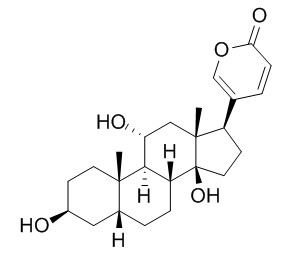Gamabufotalin
Gamabufotalin has been used for treatment of COX-2-mediated diseases and cancer therapy, it triggers c-Myc degradation via induction of WWP2 in multiple myeloma(MM) cells. Gamabufotalin strongly inhibit cancer cell growth and inflammatory response, it inhibits angiogenesis by inhibiting the activation of VEGFR-2 signaling pathways and could be a potential candidate in angiogenesis-related disease therapy.
Inquire / Order:
manager@chemfaces.com
Technical Inquiries:
service@chemfaces.com
Tel:
+86-27-84237783
Fax:
+86-27-84254680
Address:
1 Building, No. 83, CheCheng Rd., Wuhan Economic and Technological Development Zone, Wuhan, Hubei 430056, PRC
Providing storage is as stated on the product vial and the vial is kept tightly sealed, the product can be stored for up to
24 months(2-8C).
Wherever possible, you should prepare and use solutions on the same day. However, if you need to make up stock solutions in advance, we recommend that you store the solution as aliquots in tightly sealed vials at -20C. Generally, these will be useable for up to two weeks. Before use, and prior to opening the vial we recommend that you allow your product to equilibrate to room temperature for at least 1 hour.
Need more advice on solubility, usage and handling? Please email to: service@chemfaces.com
The packaging of the product may have turned upside down during transportation, resulting in the natural compounds adhering to the neck or cap of the vial. take the vial out of its packaging and gently shake to let the compounds fall to the bottom of the vial. for liquid products, centrifuge at 200-500 RPM to gather the liquid at the bottom of the vial. try to avoid loss or contamination during handling.
BMC Biotechnol.2024, 24(1):94.
Journal of Ginseng Research2022, j.jgr.2022.09.005.
Int J Mol Sci.2018, 19(2)
Pharmaceuticals (Basel).2024, 17(9):1130.
Food Chem X.2024, 21:101127.
ACS Omega.2023, 9(1):1278-1286.
Separation Science Plus2022, sscp.202200048.
Pharmaceutical Chemistry Journal2019, 52(12):986-991
Front Immunol.2020, 11:598556.
Plants (Basel).2023, 12(6):1259.
Related and Featured Products
Oncotarget. 2016 Jan 19;7(3):3533-47.
Gamabufotalin, a major derivative of bufadienolide, inhibits VEGF-induced angiogenesis by suppressing VEGFR-2 signaling pathway.[Pubmed:
26657289 ]
Gamabufotalin (CS-6), a main active compound isolated from Chinese medicine Chansu, has been shown to strongly inhibit cancer cell growth and inflammatory response. However, its effects on angiogenesis have not been known yet.
METHODS AND RESULTS:
Here, we sought to determine the biological effects of CS-6 on signaling mechanisms during angiogenesis. Our present results fully demonstrate that CS-6 could significantly inhibit VEGF triggered HUVECs proliferation, migration, invasion and tubulogenesis in vitro and blocked vascularization in Matrigel plugs impregnated in C57/BL6 mice as well as reduced vessel density in human lung tumor xenograft implanted in nude mice. Computer simulations revealed that CS-6 interacted with the ATP-binding sites of VEGFR-2 using molecular docking. Furthermore, western blot analysis indicated that CS-6 inhibited VEGF-induced phosphorylation of VEGFR-2 kinase and suppressed the activity of VEGFR-2-mediated signaling cascades.
CONCLUSIONS:
Therefore, our studies demonstrated that CS-6 inhibited angiogenesis by inhibiting the activation of VEGFR-2 signaling pathways and CS-6 could be a potential candidate in angiogenesis-related disease therapy.
Oncotarget. 2016 Mar 29;7(13):15725-37.
Gamabufotalin triggers c-Myc degradation via induction of WWP2 in multiple myeloma cells.[Pubmed:
26894970 ]
Deciding appropriate therapy for multiple myeloma (MM) is challenging because of the occurrence of multiple chromosomal changes and the fatal nature of the disease.
METHODS AND RESULTS:
In the current study, Gamabufotalin (GBT) was isolated from toad venom, and its tumor-specific cytotoxicity was investigated in human MM cells. We found GBT inhibited cell growth and induced apoptosis with the IC50 values <50 nM. Mechanistic studies using functional approaches identified GBT as an inhibitor of c-Myc. Further analysis showed that GBT especially evoked the ubiquitination and degradation of c-Myc protein, thereby globally repressing the expression of c-Myc target genes. GBT treatment inhibited ERK and AKT signals, while stimulating the activation of JNK cascade. An E3 ubiquitin-protein ligase, WWP2, was upregulated following JNK activation and played an important role in c-Myc ubiquitination and degradation through direct protein-protein interaction. The antitumor effect of GBT was validated in a xenograft mouse model and the suppression of MM-induced osteolysis was verified in a SCID-hu model in vivo.
CONCLUSIONS:
Taken together, our study identified the potential of GBT as a promising therapeutic agent in the treatment of MM.
Mol Cancer. 2014 Aug 31;13:203.
Gamabufotalin, a bufadienolide compound from toad venom, suppresses COX-2 expression through targeting IKKβ/NF-κB signaling pathway in lung cancer cells.[Pubmed:
25175164]
Gamabufotalin (CS-6), a major bufadienolide of Chansu, has been used for cancer therapy due to its desirable metabolic stability and less adverse effect. However, the underlying mechanism of Gamabufotalin involved in anti-tumor activity remains poorly understood.
METHODS AND RESULTS:
The biological functions of Gamabufotalin (CS-6) were investigated by migration, colony formation and apoptosis assays in NSCLC cells. The nuclear localization and interaction between transcriptional co-activator p300 and NF-κB p50/p65 and their binding to COX-2 promoter were analyzed after treatment with CS-6. Molecular docking study was used to simulate the interaction of Gamabufotalin with IKKβ. The in vivo anti-tumor efficacy of Gamabufotalin was also analyzed in xenografts nude mice. Western blot was used to detect the protein expression level. Gamabufotalin (CS-6) strongly suppressed COX-2 expression by inhibiting the phosphorylation of IKKβ via targeting the ATP-binding site, thereby abrogating NF-κB binding and p300 recruitment to COX-2 promoter. In addition, Gamabufotalin induced apoptosis by activating the cytochrome c and caspase-dependent apoptotic pathway. Moreover, CS-6 markedly down-regulated the protein levels of COX-2 and phosphorylated p65 NF-κB in tumor tissues of the xenograft mice, and inhibited tumor weight and size.
CONCLUSIONS:
Our study provides pharmacological evidence that Gamabufotalin exhibits potential use in the treatment of COX-2-mediated diseases such as lung cancer.



